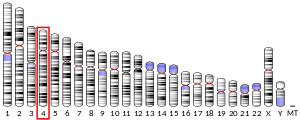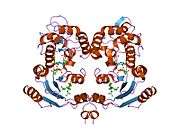BST1
Bst1 (Bone marrow stromal cell antigen 1, ADP-ribosyl cyclase 2, CD157) is an enzyme that in humans is encoded by the BST1 gene.[5][6][7] CD157 is a paralog of CD38, both of which are located on chromosome 4 (4p15) in humans.[8]
Bst1 is a stromal cell line-derived glycosylphosphatidylinositol-anchored molecule that facilitates pre-B-cell growth. The deduced amino acid sequence exhibits 33% similarity with CD38. BST1 expression is enhanced in bone marrow stromal cell lines derived from patients with rheumatoid arthritis. The polyclonal B-cell abnormalities in rheumatoid arthritis may be, at least in part, attributed to BST1 overexpression in the stromal cell population.[7]
CD157 and CD38 are both members of the ADP-ribosyl cyclase family of enzymes that catalyze the formation of cyclic ADP-ribose (cADPR) from NAD+, although CD157 is a much weaker catalyst than CD38.[9][10] cADPR is required for regulation of Ca22+ in cells.[10]
CD157 has an important role in controlling the migration of leukocytes, the adhesion of leukocytes to blood vessel walls, and the passage of leukocytes through blood vessel walls.[8]
CD157 is highly expressed in acute myeloid leukemia, and is being evaluated as a diagnostic sign, as a treatment target, and as a means of monitoring treatment progress.[11]
See also
References
- GRCh38: Ensembl release 89: ENSG00000109743 - Ensembl, May 2017
- GRCm38: Ensembl release 89: ENSMUSG00000029082 - Ensembl, May 2017
- "Human PubMed Reference:". National Center for Biotechnology Information, U.S. National Library of Medicine.
- "Mouse PubMed Reference:". National Center for Biotechnology Information, U.S. National Library of Medicine.
- Ferrero E, Lo Buono N, Morone S, Parrotta R (2017). "Human canonical CD157/Bst1 is an alternatively spliced isoform masking a previously unidentified primate-specific exon included in a novel transcript". Scientific Reports. 7 (1): 159231. Bibcode:2017NatSR...715923F. doi:10.1038/s41598-017-16184-w. PMC 5698419. PMID 29162908.
- Kaisho T, Ishikawa J, Oritani K, Inazawa J, Tomizawa H, Muraoka O, Ochi T, Hirano T (Jul 1994). "BST-1, a surface molecule of bone marrow stromal cell lines that facilitates pre-B-cell growth". Proc Natl Acad Sci U S A. 91 (12): 5325–9. Bibcode:1994PNAS...91.5325K. doi:10.1073/pnas.91.12.5325. PMC 43987. PMID 8202488.
- "Entrez Gene: BST1 bone marrow stromal cell antigen 1".
- Quarona V, Zaccarello G, Chillemi A (2013). "CD38 and CD157: a long journey from activation markers to multifunctional molecules". Cytometry Part B. 84 (4): 207–217. doi:10.1002/cyto.b.21092. PMID 23576305.
- Higashida H, Hashii M, Tanaka Y, Matsukawa S (2019). "CD38, CD157, and RAGE as Molecular Determinants for Social Behavior". CELLS. 9 (1): 62. doi:10.3390/cells9010062. PMC 7016687. PMID 31881755.
- Malavasi F, Deaglio S, Funaro A, Ferrero E, Horenstein AL, Ortolan E, Vaisitti T, Aydin S (2008). "Evolution and function of the ADP ribosyl cyclase/CD38 gene family in physiology and pathology". Physiological Reviews. 88 (3): 841–886. doi:10.1152/physrev.00035.2007. PMID 18626062.
- Yakymiv Y, Augeri S, Fissolo G, Peola S (2019). "CD157: From Myeloid Cell Differentiation Marker to Therapeutic Target in Acute Myeloid Leukemi". CELLS. 8 (12): 1580. doi:10.3390/cells8121580. PMC 6952987. PMID 31817547.
External links
Further reading
- Ortolan E, Vacca P, Capobianco A, et al. (2003). "CD157, the Janus of CD38 but with a unique personality". Cell Biochem. Funct. 20 (4): 309–22. doi:10.1002/cbf.978. PMID 12415565.
- Lee BO, Ishihara K, Denno K, et al. (1996). "Elevated levels of the soluble form of bone marrow stromal cell antigen 1 in the sera of patients with severe rheumatoid arthritis". Arthritis Rheum. 39 (4): 629–37. doi:10.1002/art.1780390414. PMID 8630113.
- Kajimoto Y, Miyagawa J, Ishihara K, et al. (1996). "Pancreatic islet cells express BST-1, a CD38-like surface molecule having ADP-ribosyl cyclase activity". Biochem. Biophys. Res. Commun. 219 (3): 941–6. doi:10.1006/bbrc.1996.0327. PMID 8645283.
- Okuyama Y, Ishihara K, Kimura N, et al. (1997). "Human BST-1 expressed on myeloid cells functions as a receptor molecule". Biochem. Biophys. Res. Commun. 228 (3): 838–45. doi:10.1006/bbrc.1996.1741. PMID 8941363.
- Muraoka O, Tanaka H, Itoh M, et al. (1997). "Genomic structure of human BST-1". Immunol. Lett. 54 (1): 1–4. doi:10.1016/S0165-2478(96)02633-8. PMID 9030974.
- Wimazal F, Ghannadan M, Müller MR, et al. (2000). "Expression of homing receptors and related molecules on human mast cells and basophils: a comparative analysis using multi-color flow cytometry and toluidine blue/immunofluorescence staining techniques". Tissue Antigens. 54 (5): 499–507. doi:10.1034/j.1399-0039.1999.540507.x. PMID 10599889.
- Yamamoto-Katayama S, Sato A, Ariyoshi M, et al. (2001). "Site-directed removal of N-glycosylation sites in BST-1/CD157: effects on molecular and functional heterogeneity". Biochem. J. 357 (Pt 2): 385–92. doi:10.1042/0264-6021:3570385. PMC 1221964. PMID 11439087.
- Liang F, Qi RZ, Chang CF (2001). "Signalling of GPI-anchored CD157 via focal adhesion kinase in MCA102 fibroblasts". FEBS Lett. 506 (3): 207–10. doi:10.1016/S0014-5793(01)02912-X. PMID 11602246.
- Yamamoto-Katayama S, Ariyoshi M, Ishihara K, et al. (2002). "Crystallographic studies on human BST-1/CD157 with ADP-ribosyl cyclase and NAD glycohydrolase activities". J. Mol. Biol. 316 (3): 711–23. doi:10.1006/jmbi.2001.5386. PMID 11866528.
- Strausberg RL, Feingold EA, Grouse LH, et al. (2003). "Generation and initial analysis of more than 15,000 full-length human and mouse cDNA sequences". Proc. Natl. Acad. Sci. U.S.A. 99 (26): 16899–903. doi:10.1073/pnas.242603899. PMC 139241. PMID 12477932.
- Funaro A, Ortolan E, Ferranti B, et al. (2005). "CD157 is an important mediator of neutrophil adhesion and migration". Blood. 104 (13): 4269–78. doi:10.1182/blood-2004-06-2129. PMID 15328157.
- Gerhard DS, Wagner L, Feingold EA, et al. (2004). "The status, quality, and expansion of the NIH full-length cDNA project: the Mammalian Gene Collection (MGC)". Genome Res. 14 (10B): 2121–7. doi:10.1101/gr.2596504. PMC 528928. PMID 15489334.
- Hillier LW, Graves TA, Fulton RS, et al. (2005). "Generation and annotation of the DNA sequences of human chromosomes 2 and 4". Nature. 434 (7034): 724–31. Bibcode:2005Natur.434..724H. doi:10.1038/nature03466. PMID 15815621.
- Liu T, Qian WJ, Gritsenko MA, et al. (2006). "Human plasma N-glycoproteome analysis by immunoaffinity subtraction, hydrazide chemistry, and mass spectrometry". J. Proteome Res. 4 (6): 2070–80. doi:10.1021/pr0502065. PMC 1850943. PMID 16335952.
This article incorporates text from the United States National Library of Medicine, which is in the public domain.











